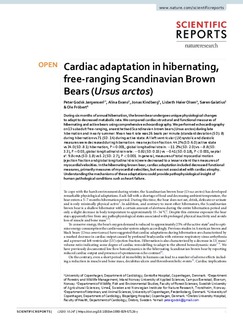| dc.contributor.author | Jørgensen, Peter Godsk | |
| dc.contributor.author | Evans, Alina L. | |
| dc.contributor.author | Kindberg, Jonas | |
| dc.contributor.author | Olsen, Lisbeth Høier | |
| dc.contributor.author | Galatius, Søren | |
| dc.contributor.author | Fröbert, Ole | |
| dc.date.accessioned | 2020-02-17T12:13:17Z | |
| dc.date.available | 2020-02-17T12:13:17Z | |
| dc.date.created | 2020-01-27T09:38:48Z | |
| dc.date.issued | 2020 | |
| dc.identifier.issn | 2045-2322 | |
| dc.identifier.uri | http://hdl.handle.net/11250/2641965 | |
| dc.description.abstract | During six months of annual hibernation, the brown bear undergoes unique physiological changes to adapt to decreased metabolic rate. We compared cardiac structural and functional measures of hibernating and active bears using comprehensive echocardiography. We performed echocardiography on 13 subadult free-ranging, anaesthetised Scandinavian brown bears (Ursus arctos) during late hibernation and in early summer. Mean heart rate was 26 beats per minute (standard deviation (SD): 8) during hibernation vs 71 (SD: 14) during active state. All left ventricular (LV) systolic and diastolic measures were decreased during hibernation: mean ejection fraction: 44.2% (SD: 6.0) active state vs 34.0 (SD: 8.1) hibernation, P = 0.001; global longitudinal strain: −11.2% (SD: 2.0) vs −8.8 (SD: 3.3), P = 0.03; global longitudinal strain rate: −0.82 (SD: 0.15) vs −0.41 (SD: 0.18), P < 0.001; septal e’: 9.8 cm/s (SD: 1.8) vs 5.2 (SD: 2.7), P < 0.001. In general, measures of total myocardial motion (ejection fraction and global longitudinal strain) were decreased to a lesser extent than measures of myocardial velocities. in the hibernating brown bear, cardiac adaptation included decreased functional measures, primarily measures of myocardial velocities, but was not associated with cardiac atrophy. Understanding the mechanisms of these adaptations could provide pathophysiological insight of human pathological conditions such as heart failure. | |
| dc.language.iso | eng | |
| dc.title | Cardiac adaptation in hibernating, free-ranging Scandinavian Brown Bears (Ursus arctos) | |
| dc.type | Peer reviewed | |
| dc.type | Journal article | |
| dc.description.version | publishedVersion | |
| dc.source.volume | 10 | |
| dc.source.journal | Scientific Reports | |
| dc.identifier.doi | 10.1038/s41598-019-57126-y | |
| dc.identifier.cristin | 1782435 | |
| dc.relation.project | Andre: Swedish Association for Hunting and Wildlife Management | |
| dc.relation.project | Andre: Austrian Science Fund | |
| dc.relation.project | Andre: Norwegian Directorate for Nature Management | |
| dc.relation.project | Andre: Swedish Environmental Protection Agency | |
| dc.relation.project | Andre: Lundbeck Foundation (R126-2012-12408) | |
| dc.relation.project | Norges forskningsråd: xxxxxx | |
| dc.relation.project | Andre: Nordforsk researcher network grant (project no. 44042) | |
| cristin.unitcode | 209,2,3,0 | |
| cristin.unitname | Institutt for skog- og utmarksfag | |
| cristin.ispublished | true | |
| cristin.fulltext | original | |
| cristin.qualitycode | 1 | |
